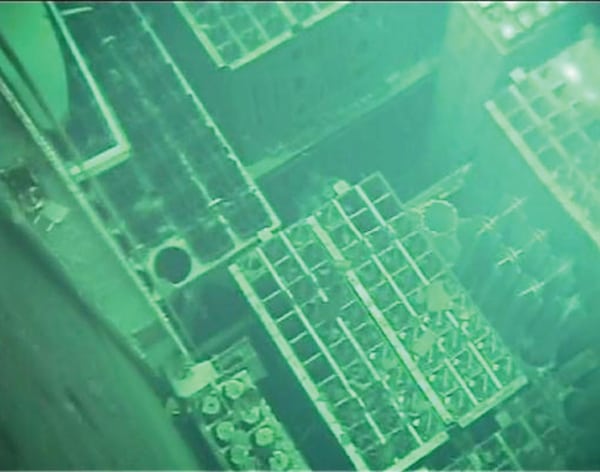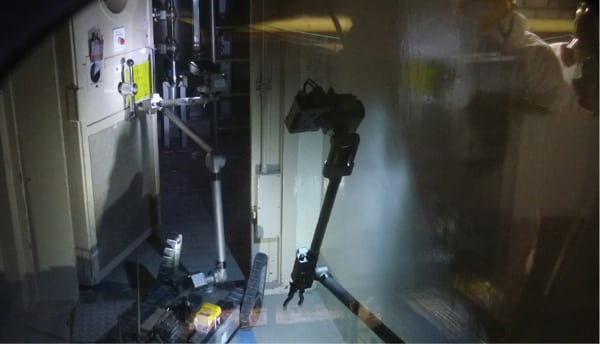Recovery Efforts Continue at Fukushima Daiichi
In April, Japan’s Nuclear and Industrial Safety Agency provisionally raised the accident rating for three reactors at the crippled six-unit Daiichi nuclear plant in Fukushima Prefecture to Level 7—making it a “major accident” and putting it on par with the 1986 Chernobyl accident in the Ukraine. Recovery efforts continue at the nuclear plant with workers pumping massive amounts of freshwater into Units 1, 2, and 3 and spraying it over the spent fuel pool of Unit 4.
Plant operator Tokyo Electric Power Co. (TEPCO) has said that as much as 55% of Unit 1’s reactor core is thought to be impaired—and the damage may be inhibiting the flow of coolant water, leading to higher temperatures and pressures; Unit 2’s core is estimated to be 35% damaged, as is 30% of Unit 3’s core. Nitrogen gas continues to be injected into the containment vessel in Unit 1 to reduce chances of hydrogen combustion.
Units 5 and 6, which were not in service when the devastating 14-meter tsunami on March 11 took out the power and debilitated cooling systems for the other units, remain in cold shutdown. Concerns continue about the condition of Unit 4, which also wasn’t operating at the time of the natural disaster but which, on March 15, saw an explosion in the top part of the building near the spent fuel pond, subsequent fires, and heightened radiation levels. TEPCO continues to top up water levels in the spent fuel pool (Figure 2), which had dropped due to evaporation caused by the heat load from its 1,331 fuel assemblies. Worries are also mounting about the structural integrity of the building and its ability to support the pond.
 |
| 2. Pooling resources. This image from a video taken on April 28 shows Daiichi 4’s spent fuel pool. The unit, which has experienced fewer problems than Daiichi 1, 2, and 3, has had both a hydrogen explosion and fires since March 11 even though it was shut down and all of its 1,331 spent fuel rods and 204 unused fuel rods were being stored in the spent fuel pool. A water sample from the pool in April showed high levels of radioactive iodine and cesium—indicating that some spent fuel rods have been damaged. Courtesy: TEPCO |
Radiation at various locations at the nuclear plant continues to surge. The highest doses have been detected from debris left on the ground after explosions at Units 1, 2, 3, and 4. Readings of rubble beside Unit 3 have surged to 300 millisieverts per hour, while others are at around 40 millisieverts per hour. Highly contaminated water continues to be another pressing concern. TEPCO has yet to decide how to process massive amounts of radioactive water being pumped from the basement of Unit 2’s turbine building.
Meanwhile, TEPCO has begun using a PackBot—a small robot on tank-like treads—to monitor radiation and oxygen levels at the units. Of four PackBots in use, two are equipped to take temperature readings and two are “Warriors,” serving to lift and haul heavy loads (Figure 3).
 |
| 3. Artificial intelligence. TEPCO in April began using PackBots to assess damage and monitor temperatures, radiation levels, and oxygen inside the crippled Fukushima Daiichi units. The PackBot seen here (in black) working inside the reactor building at Unit 3 on April 17, has on-board lights and cameras and is able to move through buildings, opening doors with a mechanized arm. Courtesy: TEPCO |
The accident continues to cause financial worries for TEPCO, Asia’s largest utility, whose shares have slumped nearly 80% since the incident began on March 11. As the utility braces for a massive bill to compensate local residents, three banks that last month made a total of 1.4 trillion yen in emergency loans to the beleaguered company booked a combined loss of 160 billion yen at the end of Japan’s financial year on March 31. A rough draft of TEPCO’s compensation plan has shown that the government could cap the utility’s liability at 2 trillion yen to 3.8 trillion yen. Other utilities that operate nuclear plants may be asked to contribute to the fund, which could ultimately add up to 2.7 trillion yen.
Among newer developments, Japanese authorities plan to launch an independent panel in mid-May to investigate the causes of the accident at Daiichi. Prime Minister Naoto Kan told a plenary session at the House of Representatives that the lessons would be shared with the international community and that Japan would “take the lead in contributing to safety improvements of nuclear plants around the world.”
—Sonal Patel is POWER‘s senior writer.